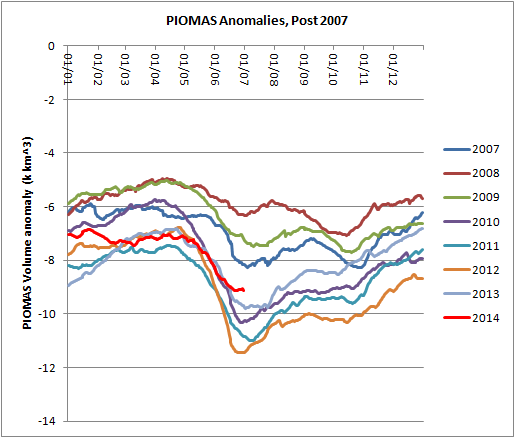Viddalo,
I have no hard answers, just some guesses.
The really big clue is this - PIOMAS anomalies show that in all the post 2007 years, but especially so after 2010 the spring volume loss expressed as an anomaly (1980 to 1999) undergoes an inflection around the solstice - I suspect that any coherent explanation must address this observation to be convincing.

The other issue that graph raises is that whatever happens between May and the Solstice was made stronger by the 2010 volume loss event, but was already present. As those are anomalies it wasn't present in the 1980 to 1999 average, and visual inspection of graphs shows its regular appearance to be a new phenomenon.
Going back to 2010 and the Central Arctic...
I've re-jigged some code to convert volume as a function of grid box thickness, into area as a function of grid box thickness. So I can now work out PIOMAS sea ice area contributions from various grid box thicknesses. Note that the area is not directly comparable with other sea ice indices although it's fairly close.

So that is a plot showing what area each thickness band conributed to overall area each year in April. Note how the pack has undergone a general thinning. Note that 2010 saw a drop in ice over 3m thick (with a small recovery after) - this was due to the over winter export of a lot of multi year ice. But the effect it has on grid boxes reporting an April thickness 1 to 1.9m was to increase the area coverage of such grid boxes notably. Would we expect more thinning from thinner ice earlier in the season? I suspect so, but why? I must admit I can't put my finger on the physics of it.
Note that since 2007 there has been a net shift towards first year ice, that might explain the more muted spring melts and their attendant solstice inflections.
***
Stepping back for a better view of the long term trend, the way its working is that as ice from (for example) 3 to 3.9 declines it 'dumps' volume down into the next lowest thickness band. To show this long term behaviour I have taken a three year average of the data behind the above graph, then caculated as anomalies from the 1980 to 1999 average.

So as the ice area due to grid boxes over 3m has declined there has been a near identical increase in the area from grid boxes with an April thickness of 2.99m and below.
Not very informative, it's rather obvious,, but I liked the result graphically.
